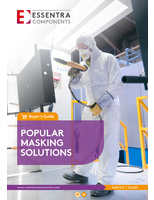L A Aluminum Adds Dry Ice Blasting!
L A Aluminum Casting Company in Hayden, Idaho has added dry ice blasting to the rest of their single source manufacturing processes available to potential and existing customers. Dry ice blasting is simply another service offered in addition to engineering and design assistance, tool making, aluminum casting, CNC machining, and final assembly. Dry ice blasting can be used to clean engines, tooling, walls, and almost any surface where abrasive blasting would damage the surface. L A Aluminum is using the process internally to clean customer tooling. Dry ice blasting is not damaging to the surface of tooling or molds, therefore customer molds will last longer. This saves the customer thousands of dollars each year in tool re-surfacing or new tooling purchases. This is simply another way L A Aluminum serves their customer base.
Dry ice blasting is similar to sand blasting, plastic bead blasting, or soda blasting where a medium is accelerated in a pressurized air stream to impact a surface to be cleaned or prepared. Instead of using hard abrasive media to grind on a surface (and damage it), dry ice blasting uses soft dry ice, accelerated at supersonic speeds, and creates mini-explosions on the surface to lift the undesirable item off the underlying substrate.
Dry ice blasting has many unique and superior benefits over traditional blasting media.
Dry ice blasting:
Dry ice blasting uses compressed air to accelerate frozen carbon dioxide (CO2) "dry ice" pellets to a high velocity. A compressed air supply of 80 PSI/50 scfm can be used in this process. Dry ice pellets can be made on-site or supplied. Pellets are made from food grade carbon dioxide that has been specifically approved by the FDA, the EPA and the USDA.
Carbon dioxide is a non-poisonous, liquefied gas, which is both inexpensive and easily stored at work sites.
How does CO2 Blasting Work?
CO2 blasting works because of three primary factors: pellet kinetic energy, thermal shock effect and thermal-kinetic effect. Dry ice blasting optimizes blast performance for each application by combining these forces and adjusting:
Pellet Kinetic Energy
The dry ice blasting process incorporates high velocity (supersonic) nozzles for surface preparation and coating removal applications. Since kinetic impact force is a product of the pellet mass and velocity over time, the delivery system propels the pellets to the highest velocities attainable.
Even at high impact velocities and direct head-on impact angles, the kinetic effect of solid CO2 pellets is minimal when compared to other media (grit, sand, PMB). This is due to the relative softness of a solid CO2, which is not as dense and hard, as other projectile media. Also, the pellet changes phase from a solid to a gas almost instantaneously upon impact, which effectively provides an almost nonexistent coefficient of restitution in the impact equation. Very little impact energy is transferred into the coating or substrate, so the dry ice blasting process is considered to be nonabrasive.
Thermal Shock Effect
Instantaneous sublimation (phase change from solid to gas) of CO2 pellet upon impact absorbs maximum heat from the very thin top layer of surface coating or contaminant. Maximum heat is absorbed due to latent heat of sublimation.
The very rapid transfer of heat into the pellet from the coating top layer creates an extremely large temperature differential between successive micro-layers within the coating. This sharp thermal gradient produces localized high shear stresses between the micro-layers. The shear stresses produced are also dependent upon the coating thermal conductivity and thermal coefficient of expansion / contraction, as well as the thermal mass of the underlying substrate. The high shear produced over a very brief expanse of time causes rapid micro-crack propagation between the layers leading to contamination and/or coating final bond failure at the surface of the substrate.
Thermal-Kinetic Effect
The combined impact energy dissipation and extremely rapid heat transfer between the pellet and the surface cause instantaneous sublimation of the solid CO2 into gas. The gas expands to nearly 800 times the volume of the pellet in a few milliseconds in what is effectively a "Micro-explosion" at the point of impact.
The "Micro-explosion," as the pellet changes to gas, is further enhanced for lifting thermally-fractured coating particles from the substrate. This is because of the pellet's lack of rebound energy, which tends to distribute its mass along the surface during the impact. The CO2 gas expands outward along the surface and its resulting "explosion shock front" effectively provides an area of high pressure focused between the surface and the thermally fractured coating particles. This results in a very efficient lifting force to carry the particles away from the surface.
Technical Information provided by Cold Jet.com.




